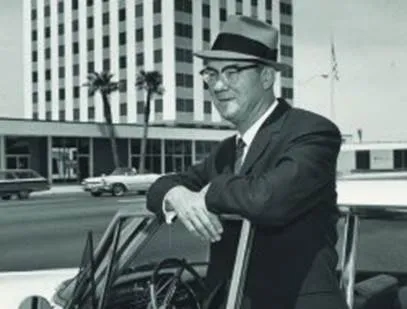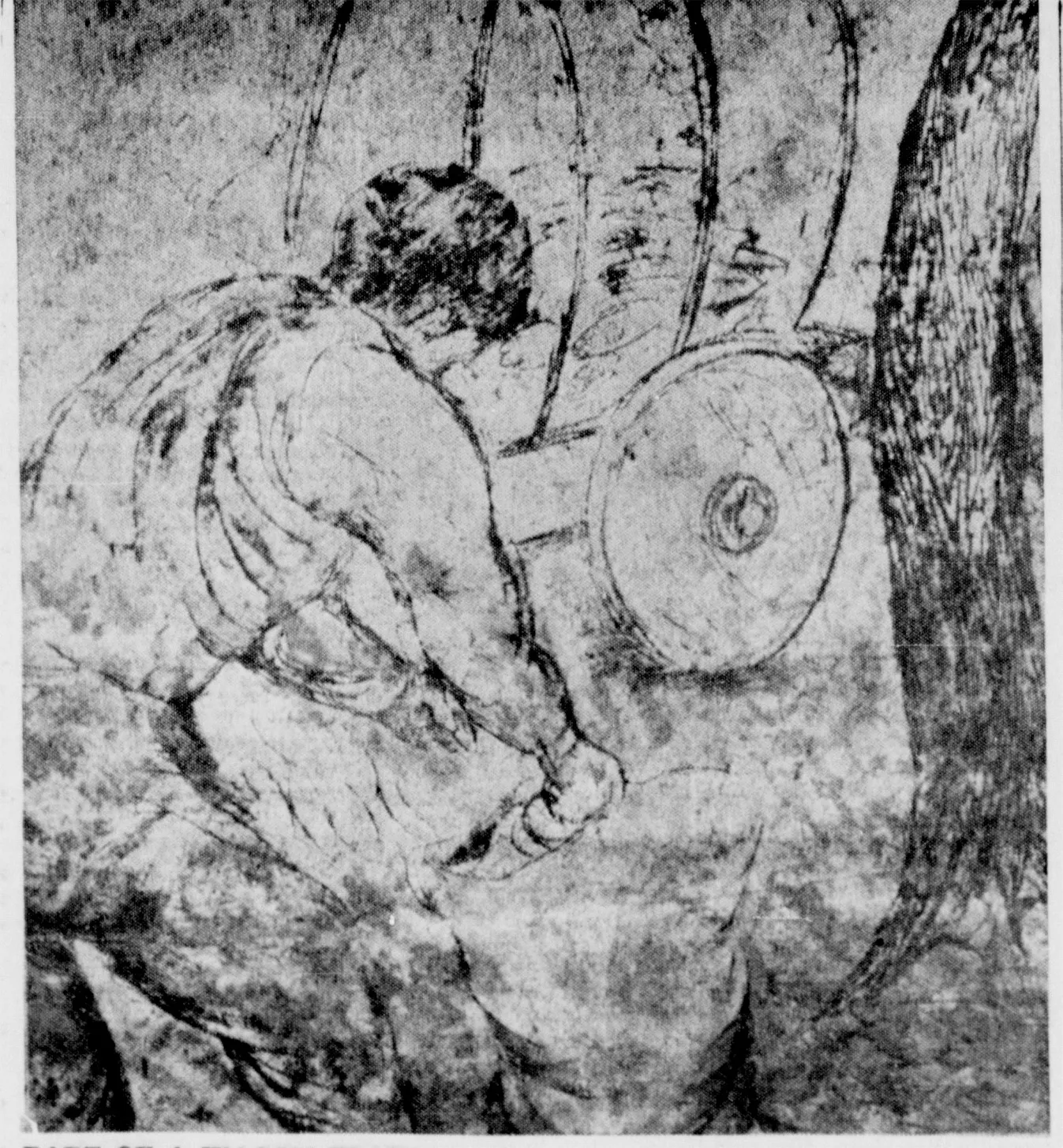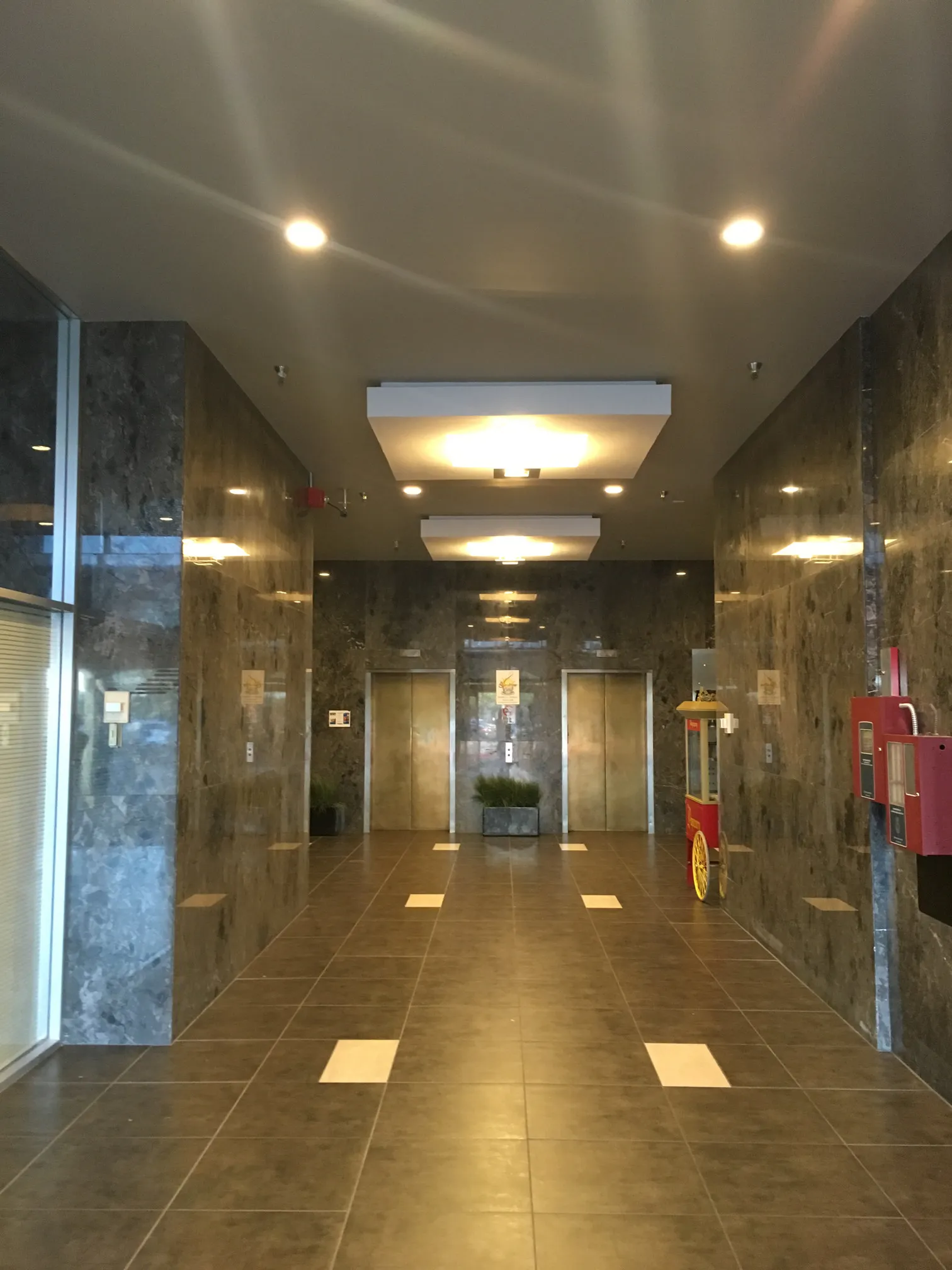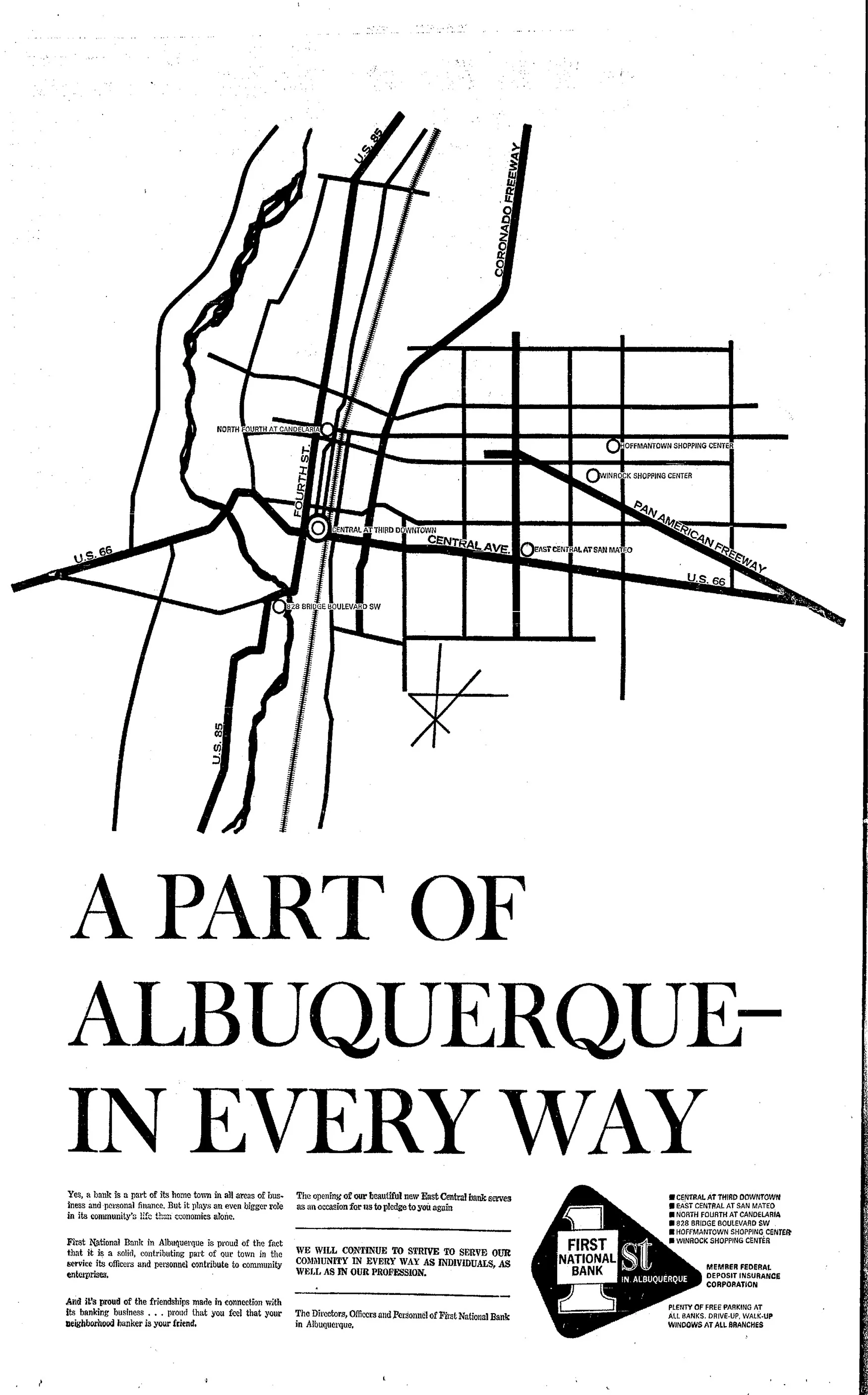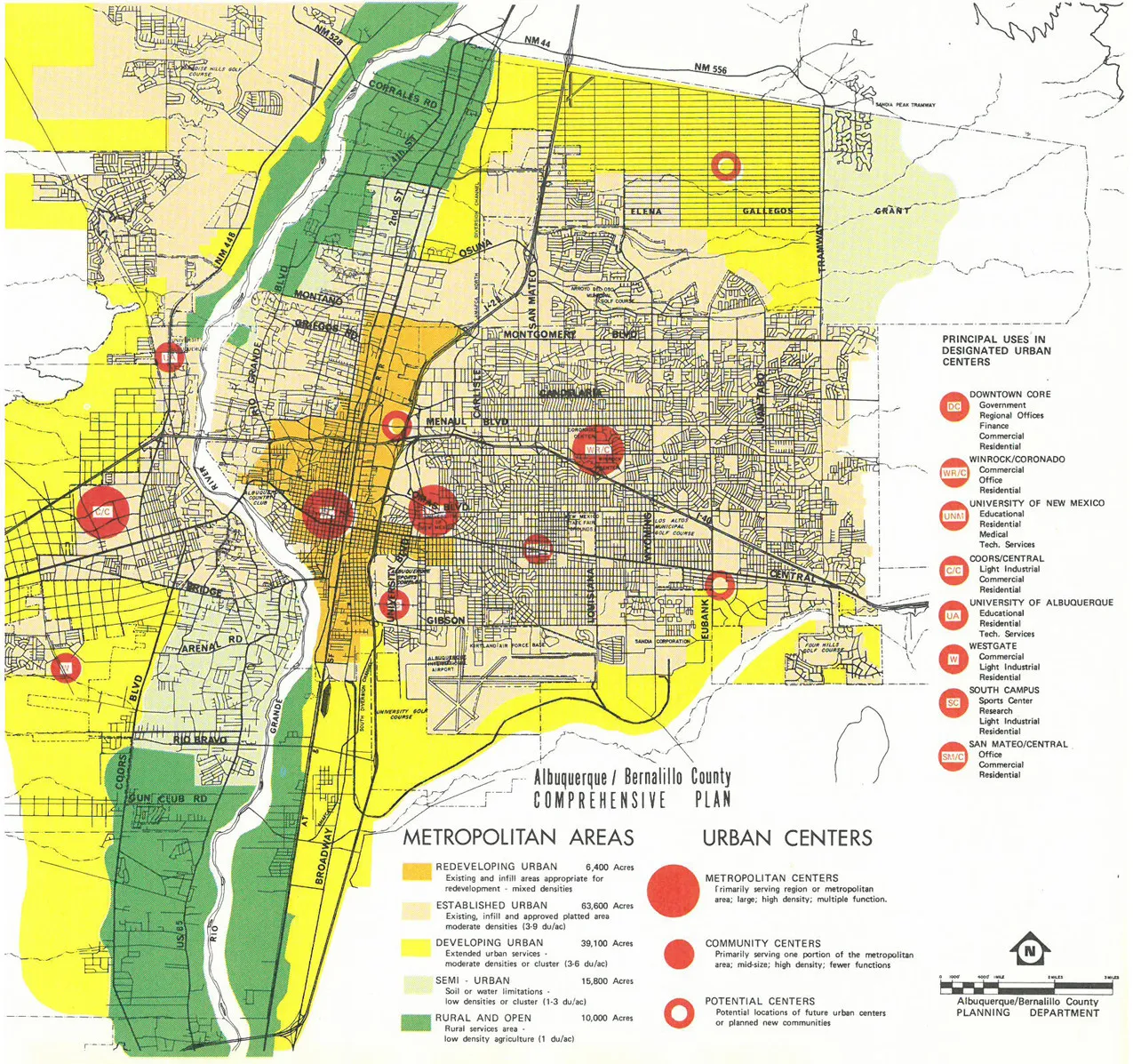1963
Flatow, Moore, Bryan and Fairburn
Case study by:
Alexa Murphy,Fri Oct 09 2015
First National Bank Building
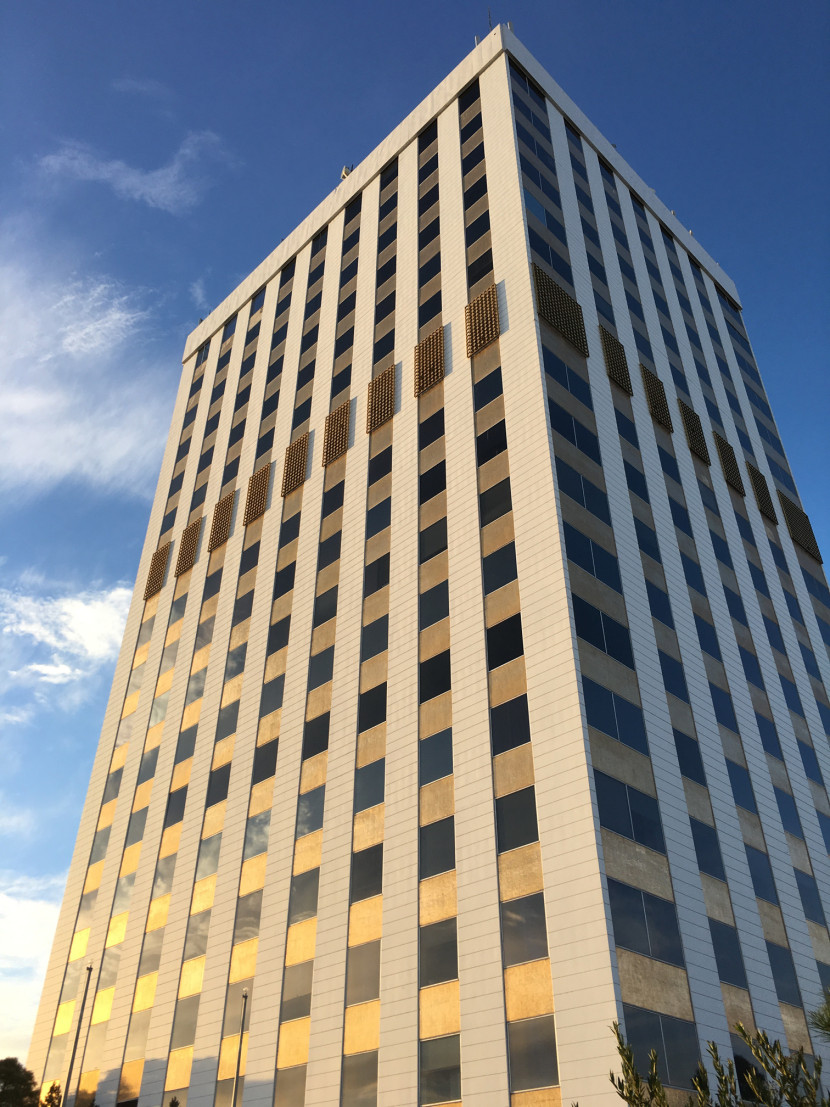
The First National Bank Building East, also called the Bank of the West Tower, is located at 5301 Central Avenue, NE, at the intersection with San Mateo Boulevard in Albuquerque. The Del Webb Corporation financed the modernist tower, which was designed by the now-defunct architectural firm Flatow, Moore, Bryan and Fairburn. Clad in gold mosaic tiles, a construction worker reportedly called it “Horizon Pillar.”1 The tower was the tallest building in New Mexico at 212 feet and 17 stories at the time of its completion in 1963. Sited to shift the First National Bank’s primary branch from its historic downtown tower, it has been primarily occupied by banking institutions and various offices; the New Mexico Department of Motor Vehicles and other state offices currently occupy the tower. The First National Bank Building East is still the tallest building in New Mexico outside of downtown Albuquerque, which now makes it look like an oddity surrounded by single-story sprawl. Why was a gilded “skyscraper” built so far from downtown Albuquerque? The tower’s site could have been one of the city’s many nodal centers, and now serves as an artifact of Albuquerque’s development and urban form that should be celebrated as a unique and defining landmark of the city.
Formal Characteristics:
Site
Flatow, Moore, Bryan and Fairburn designed the tower as the cornerstone of a larger commercial campus called First National Bank Center, planned to cover “five and one-half blocks” in the newly annexed East Mesa a few miles east of downtown.2 The campus development was half of a twin project built concurrently in downtown Phoenix, including an identical tower.3 In Albuquerque, the First National Bank leased the square block on which the tower rose to the Del Webb Corporation for 99 years. The site accommodated 650 parking spaces oriented to the tower’s north entrance.4 Flatow organized the tower’s entrances on a north-south axis. Marble-clad pyramidal canopies shaded pedestrians walking from Central Avenue, indicating the potential to be a part of a new dense city center. Route 66 was already a major axial road prior to I-40’s completion north of the site, and the height of the tower reportedly caused traffic congestion during construction. As reported by the Albuquerque Tribune, “City Traffic Department had complained that motorists slowing to count the floors of the now-completed 17-story building were snarling traffic” so the contractor painted “numeral signs on the project to clearly mark each floor and show daily progress on the building’s growth.”5
Height, Elevation, and Structure
The First National Bank Building East’s modern structural system and elevators enabled its great height of 212 feet and 17 stories. The building’s modern open office floor plans were the result of plate spans supported by core and outside columns and cast-in-place pre-stressed concrete girders with a post-tensioning system. Reduced beam depths allowed for the inclusion of an extra floor. As early advertisements noted, four high-speed “programmed” elevators served building occupants efficiently without excessive wait times. In adjacent elevator lobbies, a glass mail chute also connected each level, allowing office occupants to drop lots of small correspondence without the inconvenience of traveling to ground level.
The architects clad the façade in materials largely intended to reduce solar heat gain and resultant stress on cooling systems: concrete panels painted white, gray tinted heat-reducing glazing, and one-inch square gold ceramic mosaic tiles at the spandrels. These materials further reacted to the climate by blending with Albuquerque’s Southwestern environment: the gold tiles catch and magnify sunlight at sunset, while white concrete panels reflect tonal atmospheric light, usually a watermelon color at sunset or light blue during storms. The use of gold tile can also be appreciated in reference to the Sunbelt’s postwar urban boom, when tourist and booster brochures claimed Albuquerque to be sun capital of the world and the newspaper tallied successive sunny days. Celebration of the desert sun was typical in the promotion and development of Sunbelt cities, making the tower’s identical twin in Phoenix equally appropriate.6
Flatow, Moore, Bryan and Fairburn organized the cladding materials on a grid indicating the scale of offices and floors. They mounted a gold-tinted decorative aluminum screen at the tenth floor. Large blue signage crowned the building, announcing the First National Bank despite the architects considering it aesthetically unpleasing.7 In 1963, a news article contextualized the tower’s size and materials for local readers in relation to the nicest homes in their new and rapidly growing suburban neighborhoods:
Del Webb Corp used 725 tons of reinforced steel, enough to build the foundations for 3,600 houses; a 557-ton refrigeration unit, enough to cool 160 three-bedroom homes and 20,000 square feet of ceramic tile trim on the 196,232 square-foot structure.8
The tower’s completion in 1963 coincided with the ongoing suburban housing boom in Sunbelt cities across the U.S., which was especially visible in Albuquerque’s East Mesa surrounding the tower. The suburban terms and scale used to describe the tower were thus highly familiar to most readers of this era, and illustrated the impressive size of the tower in relation to their individual homes.
Program
Flatow, Moore, Bryan and Fairburn organized the building’s uses by level. The first two levels hosted the bank’s public functions, including lobby, teller, and offices.9 The basement level held a café, event space, and lock box storage and vaults. The rest of the floors were occupied by various offices, including Flatow, Moore, Bryan and Fairburn themselves,10 The exception of the top two floors, which housed the Albuquerque City Club:
a ‘first’ for the East Heights [Mesa] with a potential membership of 500. Club accommodations will include a continental restaurant, cocktail lounge, stag room, barber shop and beauty facilities, snooze and massage rooms and a gymnasium. A rooftop garden will be fully landscaped and surrounded by glass panels. All these features will be pleasantly situated 200 feet above ground level, offering a complete view of the sprawling metropolis below.11
The planned social club at the top two floors literally elevated new East Mesa society, complete with views focused on the sprawling urban landscape. These new views celebrated club members’ accomplishments in the domestication of the Western wilderness through urbanization and subsequent generation of real estate profits, overshadowing traditionally sought-after views of the natural environment.
Interiors and Murals
Interior finishes supported the opulence of the exterior finishes and bank program. Green marbles, walnut, and other traditional bank materials clad the first two floors. Modern bubble lights and floor-to-ceiling storefronts created an open atmosphere to welcome visitors. In addition to marble cladding at elevator lobbies, eight-by-twelve foot murals on fifteen floors, produced by local artist Alice Garver, depicted different periods in New Mexico history as researched and selected by Albuquerque historian Alan Minge.12 Garver created the murals using a signature process of sketching images, applying color to the back of rice paper, and “rubbing until desired effect was achieved.” Then, the artist adhered the compositions to the lobby walls with wheat paste. Subjects included the Duke of Alburquerque at the 17th floor City Club, “Atomic Age” at the 16th floor, a wagon mural on the 10th floor, and “Early Indian” at the second floor with the following inscription:
There is no part of the United States offering such excellent illustrations of the value of historical studies, as the territory of New Mexico. Ever since the first arrival of the Caucasian branch, it has stood in the presence here of another ramification of the human race, different physical features, but much more distant in ethnological development. (Quote by Adolf F Bandelier, April 28, 1882.)13
The organization of these murals suggests a historical progression similar to that offered by Frederick Jackson Turner’s Frontier Thesis. According to Turner, successive waves of technologically advanced pioneers developed increasingly sophisticated settlements when introduced to “primitive” cultures and wilderness at the fringe of the known world. Domestication of urban life and pursuit of wealth pushed the next generation of restless pioneers to new frontiers for settlement. Turner lamented the closing of the American Frontier in the late 19th century, however the frontier spirit survived in the form of suburban development during the postwar era.14 Instead of pointing wagons west, postwar pioneers drove modern cars outward from established downtowns to settle the suburban fringe. In this context, the real estate developers, designers, and financers who comprised the East Mesa social club and leased expensive offices in the tower were appropriately placed alongside depictions of pioneers, founders, and astronauts. During this era, banking institutions, new subsidies, and loan practices became key to financing construction and urban expansion, casting the people of these institutions as pioneers of the modern era, including complex positive and negative consequences.15
Urban Context
The First National Bank Building East opened to great fanfare in February 1963, indicating its importance to the city. Enthusiastic responses included a special edition of the Albuquerque Tribune business section celebrating the bank and businessmen key to the new tower and East Mesa development. Most articles announcing the new building focused on the experience and business acumen of the mostly Anglo bank branch operations staff, directors, and managers. The biographies typically included impressive educational credentials, how long they had lived in New Mexico or if their wife was from New Mexico, information about their families, and home addresses. These profiles demonstrated the banker’s stability and legitimacy; they also humanized the bank and introduced it as a member of the community. A smaller percentage of articles describing the tower’s structure and interior design espoused the modern “skyscraper” and the use of traditional bank finishes like marble and walnut. The building was a symbol to legitimize investment in urban growth.
Banking was key to East Mesa and other new Albuquerque development during this era, as both large developers and individual homeowners began to depend on loans and complex financing for real estate construction and purchase. Many of the profiles of bank executives illustrated the connection between banking and real estate development: one example is that of J.W. Karr, who was a member of the City Commission from 1930-34, president of the Rotary Club, president of the Albuquerque Board of Realtors, member of the Chamber of Commerce, and director of First National Bank.16
Nodal development has become a defining feature of the suburban metropolis since the 1980s, however Albuquerque is unique because it has a long history of decentralized development.17 The establishment of downtown, or New Town, occurred alongside the arrival of the railroad in the late 1800s and rose east of the original Old Town, resulting in economic competition for primacy.18 Similarly, the later selection of the new bank complex site in the 1950s, with its location outside of downtown, may have been a part of an economic competition between two rival chambers of commerce during that time: new East Mesa development versus established downtown. Developers unsuccessfully lobbied to locate a new major civic building at the East Mesa instead of downtown in an attempt to establish a new urban and commercial core.19 Although pedestrian density on the East Mesa didn’t materialize as planned, the location of the bank tower indicates the city’s continuous commitment to nodal development. An advertisement locating bank branches, including the tall First National Bank Building tower, located downtown, described a pattern of edge development around the city during the boom of the 1950s and 1960s. Later planning documents produced and distributed by the City of Albuquerque Planning Department in 1975 formalized the nodes indicated by bank branch locations.20 Today, small clusters of towers at many of these nodes define commercial zones surrounded by suburban housing developments and services connected by arterial roads.
Conclusion
After the completion of the First National Bank Building East in 1963, developers built a 10-story sister building in 1975 for an insurance company, located north of the bank tower.21 In addition, Harvey Hoshour, another notable Albuquerque modernist architect, designed a small neighboring drive-up bank building. Small office and service buildings, apartments, and houses grew around the tower, punctuated by parking lots. City Directories indicate that tower occupancies began to fluctuate in the 1980s.22 In time, the elevator lobby murals were painted over, destroyed, and largely forgotten; little of Alice Garver’s work remains because of the media’s delicate nature.23 The City Club became defunct; someone eventually converted the top floors into two leasable residential penthouses. Bank of the West replaced the First National Bank and its signage at the top of the tower, until the 2007-2008 real estate crash and associated banking crisis caused them to vacate.
Although the signage that Flatow considered a blemish is finally gone, the tower is now largely nameless. This state is inadequate for such a large modernist historical landmark. As early Spanish conquistadors came to the Rio Grande Valley speculating for gold, later waves of Anglos came to Albuquerque in the postwar era for real estate speculation. The First National Bank Building East embodied their dreams of affluence and wealth. The complex social and ecological legacy of the frontier has indelibly marked daily life in the western Sunbelt city. Sprawl and a nodal character are as much artifacts of the frontier mentality as the original western Sunbelt city itself. The tower should return to the name first christened by one of the construction workers who built it: Horizon Pillar.
“Postcard from Albuquerque,” https://www.facebook.com/Postcard-from-Albuquerque-777000625682498/timeline/.
Footnotes
-
“New Bank Building Dominates Skyline,” Albuquerque Tribune, 13 February 1963, B3. ↩
-
Ibid. ↩
-
Tobias Flatow, conversation with author, 7 October 2015. ↩
-
“New Bank Building Dominates Skyline.” ↩
-
“Traffic Snarl Stopped By Large Numerals,” Albuquerque Tribune, 13 February 1963, B6. ↩
-
“New Bank Building Dominates Skyline”; Flatow, conversation with author. ↩
-
“Max Flatow: Architecture Is an Exciting Business,” Albuquerque Tribune, 20 November 1968, C5. ↩
-
“New Bank Building Dominates Skyline.” ↩
-
Ibid. ↩
-
Hudspeth Directory Co., Hudspeth Directory Company’s Albuquerque City Directory. (El Paso, TX: Hudspeth Directory Co., 1962). ↩
-
“New Bank Building Dominates Skyline.” ↩
-
“Bank Takes Bottom Floor For New Branch Headquarters,” Albuquerque Tribune, 13 February 1963, B2. ↩
-
“Murals Completed In Bank Building,” Albuquerque Journal, 17 December 1962, B5. ↩
-
Frederick Jackson Turner, “The Significance of the Frontier in American History,” Annual Report of the American Historical Association for the Year 1893 (Washington, DC, 1894), 199-227. ↩
-
Kenneth T. Jackson, Crabgrass Frontier: The Suburbanization of the United States, (New York: Oxford University Press, 1985). ↩
-
“Karr Director For 15 Years, Local Realtor,” Albuquerque Tribune, 13 February 1963, B6. ↩
-
Joel Garreau, Edge City: Life on the New Frontier (New York: Doubleday, 1991). ↩
-
Marc Simmons, Albuquerque: A Narrative History (Albuquerque: University of New Mexico Press, 1982). ↩
-
Michael F. Logan, Fighting Sprawl and City Hall: Resistance to Urban Growth in the Southwest (Tucson: University of Arizona Press, 1995). ↩
-
Albuquerque/Bernalillo County Planning Department, Albuquerque/Bernalillo County Comprehensive Plan: Metropolitan Areas and Urban Centers Plan (Albuquerque: Albuquerque/Bernalillo County Planning Department, 1975). ↩
-
“10-story Office Building Finished,” Albuquerque Tribune, 23 October 1975, B5. ↩
-
Albuquerque City Directory (Dallas, TX: R.L. Polk & Co., 1980-89). ↩
-
Margaret Randall, “Visualizing Albuquerque,” New Mexico Mercury, 13 April 2015, accessed 20 September 2015, http://newmexicomercury.com/blog/comments/visualizing_albuquerque_at_the_albuquerque_museum. ↩

